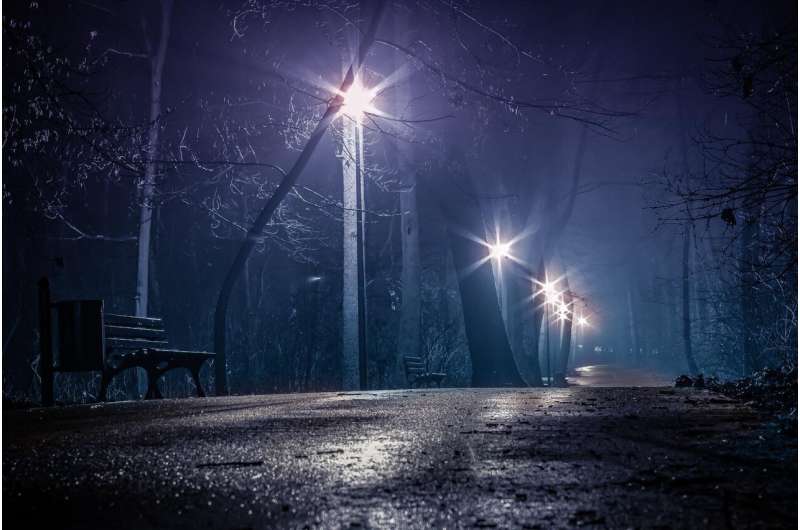This article has been reviewed according to Science X's editorial process and policies. Editors have highlighted the following attributes while ensuring the content's credibility:
fact-checked
peer-reviewed publication
trusted source
proofread
Even low levels of artificial light disrupt ecosystems

A new collection of papers on artificial light at night show the impact of light pollution to be surprisingly far-reaching, with even low levels of artificial light disrupting species communities and entire ecosystems. Published in Philosophical Transactions of the Royal Society B , the special theme issue, which includes 16 scientific papers, looks at the effects of light pollution in complex ecological systems, including soil, grassland, and insect communities.
Led by researchers at the German Center for Integrative Biodiversity Research (iDiv) and the Friedrich Schiller University Jena, the collection notes the increasing ubiquity of light pollution, while emphasizing the domino effect light pollution has on ecosystem function and stability.
Night skies are becoming brighter as the use of artificial lighting spreads across the globe. With an estimated annual uptick of up to 10%, the prevalence of light pollution is disrupting the natural light cycles that have been largely consistent throughout the Earth's history. These light cycles are vitally important to organisms who rely on light as a source of energy and information.
To date, studies looking at the impact of light pollution have largely focused on human health and individual species' responses, whereas investigating entire ecosystems, where species are linked through diverse interactions, has remained scarce.
"Species do not exist in isolation but rather interact in numerous ways," explains iDiv and the University of Jena's Dr. Myriam Hirt, who led the compilation and editing of the theme issue together with Dr. Remo Ryser. "Our aim was to better understand how the brightening of the night sky affects entire ecosystems and the benefits they provide."
Using the iDiv Ecotron, which consists of multiple controlled experimental-ecosystem chambers (so-called EcoUnits), several researchers simulated and altered light conditions at night. Key findings include the ability of artificial light to:
- reach belowground soil communities, impacting soil basal respiration and carbon-use efficiency
- influence invertebrate activity, which was linked to higher predation rates at night
- reduce plant biomass and diversity, as well as change plant traits, such as leaf hairiness
- potentially shift—homogenize—the periods when species are active, leading to increased overlap and ultimately threatening species persistence.
The studies also showed that even low intensities of light pollution—illuminance lower than that of a full moon—have profound effects not only on the behavioral and physiological responses of individual species but at more complex levels, such as communities and ecological networks, like food webs.
"Their individual responses to artificial lighting and their relationships with one another determine the outcome for the entire ecological system. For instance, an activity shift of diurnal and crepuscular species into the night increases extinction risks in the entire community," says Dr. Remo Ryser of iDiv and the University of Jena.
Another study in the issue investigated how artificial light produces indirect cascading effects with implications for humans. For example, changes in the abundance and behavior of mosquitoes—a vector species—in response to artificial light at night. The study shows that exposure leads to changes in the timing of key behaviors, such as host-seeking, mating, and flight activity, which might carry wide-scale consequences on the transmission of vector-borne diseases, like malaria.
Another paper looked at how different lighting strategies may mitigate the negative effects of artificial light. However, the special issue points out that flipping the switch on light pollution requires a nuanced approach given that the impact of light pollution varies significantly among species. This suggests that mitigation strategies may not be universally applicable.
As darkness disappears due to the consistent rise in artificial lighting around the world, the collection of studies highlights the cost of this expansion to people's health and ecosystems. By acknowledging the impact of this human-caused disturbance on species interactions and feedback loops, the special issue hopes to inspire future research and action that not only helps mitigate the harmful effects of light pollution, but fosters a sustainable coexistence between society's needs and the natural environment.
"The benefits of artificial light during the night are undeniable, but its adverse effects should not be ignored," says Dr. Myriam Hirt.
More information: Introduction to special issue: Myriam R. Hirt et al, Light pollution in complex ecological systems, Philosophical Transactions of the Royal Society B: Biological Sciences (2023). DOI: 10.1098/rstb.2022.0351
Journal information: Philosophical Transactions of the Royal Society B


















